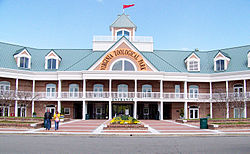Virginia Zoological Park
 Main Entrance | |
| Date opened | 1900[1] |
|---|---|
| Location | Norfolk, Virginia, United States |
| Coordinates | 36°52′43″N 76°16′39″W / 36.8786°N 76.2774°WCoordinates: 36°52′43″N 76°16′39″W / 36.8786°N 76.2774°W |
| Land area | 53 acres (21 ha)[2] |
| No. of animals | 350[2] |
| No. of species | 115[2] |
| Memberships | AZA[3] |
| Website | www |
The Virginia Zoological Park is a 53-acre (21 ha) zoo located adjacent to Lafayette Park in Norfolk, Virginia, United States. The zoo opened in 1900, and was accredited by the Association of Zoos and Aquariums (AZA) in 1987.
History[]
In 1892, the City of Norfolk purchased the 65 acres (26 ha) that was currently occupied by Lafayette Park. In 1900, the park began acquiring animals to exhibit, and by 1901 its collection exceeded 200 animals, including mammals, birds and reptiles.[1]
In 1974, the facility was fenced off from the city park, and renamed Lafayette Zoological Park. Though fenced off, residents of the nearby LaValette Avenue could see the zoo's elephant exhibit from their homes. Newcomers, unfamiliar with the fact that a zoo was in the location, sometimes called the police at the sight of the elephants.[4] Between 1974 and 1980, most of the zoo's old exhibits were renovated.[1]
Also in 1974, the Friends of the Zoo was established to act as a support organization for the development of the zoo. In 1989, it was renamed as the Virginia Zoological Society and established as a non-profit organization.[1]
In 1985, Lafayette Zoological Park was renamed the Virginia Zoological Park at Norfolk (commonly known as the Virginia Zoo). In 1987, the zoo gained accreditation from the Association of Zoos and Aquariums (AZA).[1]
In 1992, a Master Plan was adopted by City of Norfolk and Virginia Zoological Society. Plans included a new Education Complex and Visitor Center, as well as African, North American, Australian, South American and Asian-themed exhibits. In 1999, Part I of Phase I opened, including Gelada baboon habitat and Xaxaba African village and 100th Anniversary of Virginia Zoo and Lafayette Park. In 2001, design for Master Plan Phase II: North America exhibit began. The following year Part II of Phase I opened: African Okavango Delta exhibit, thus completing Phase I of the Master Plan.
In 2004, Part I of Phase II opened: prairie dog habitat. The following year, the zoo got its third elephant named Cita.[5] In 2011, Part I of Phase IV opened: "Trail of the Tiger" exhibit opened with various fauna of India and Southeast Asia.
Exhibits[]
- Trail of the Tiger
This exhibit was opened in 2011. It features animals from Asia, and nearly doubles the number of large animals at the zoo. Among the animals in this exhibit are Malayan tigers, oriental small-clawed otters, Bornean orangutans, siamangs, northern white-cheeked gibbons, Malayan tapirs, binturongs, rhinoceros hornbills, fairy-bluebirds, azure-winged magpies, and chestnut-breasted malkoha. The exhibit includes a raised boardwalk over the "Asian forest", and a cave with views into the tier and orangutan exhibits. Another viewing area allows underwater views of the otters and tigers.[2]
- Okavango Delta
Named after the real life Okavango Delta in Africa, this exhibit opened in 2002.

Lioness

Tiger
References[]
- ^ a b c d e "Zoo History". virginiazoo.org. Virginia Zoo. Retrieved 3 May 2011.
- ^ a b c d "New Exhibits". virginiazoo.org. Virginia Zoo. Retrieved 3 May 2011.
- ^ "Currently Accredited Zoos and Aquariums". aza.org. AZA. Retrieved 3 May 2011.
- ^ Kimberlin, Joanne (30 May 2008). "It's a zoo out there - literally - for residents of Norfolk street". hamptonroads.com. HamptonRoads.com. Retrieved 3 May 2011.
- ^ "Norfolk zoo gets its third elephant". elephant-news.com. Elephant News. Retrieved 3 May 2011.
External links[]
 Media related to Virginia Zoological Park at Wikimedia Commons
Media related to Virginia Zoological Park at Wikimedia Commons- Official website
- Zoos in Virginia
- Buildings and structures in Norfolk, Virginia
- Tourist attractions in Norfolk, Virginia
- 1900 establishments in Virginia





